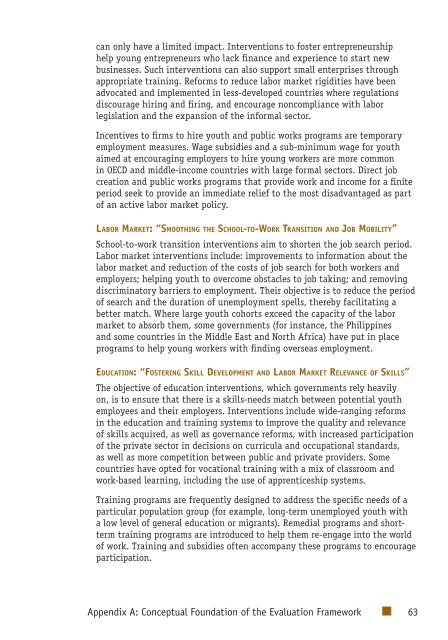Youth Employment Programs - Independent Evaluation Group
Youth Employment Programs - Independent Evaluation Group
Youth Employment Programs - Independent Evaluation Group
You also want an ePaper? Increase the reach of your titles
YUMPU automatically turns print PDFs into web optimized ePapers that Google loves.
can only have a limited impact. Interventions to foster entrepreneurshiphelp young entrepreneurs who lack finance and experience to start newbusinesses. Such interventions can also support small enterprises throughappropriate training. Reforms to reduce labor market rigidities have beenadvocated and implemented in less-developed countries where regulationsdiscourage hiring and firing, and encourage noncompliance with laborlegislation and the expansion of the informal sector.Incentives to firms to hire youth and public works programs are temporaryemployment measures. Wage subsidies and a sub-minimum wage for youthaimed at encouraging employers to hire young workers are more commonin OECD and middle-income countries with large formal sectors. Direct jobcreation and public works programs that provide work and income for a finiteperiod seek to provide an immediate relief to the most disadvantaged as partof an active labor market policy.Labor Market: “Smoothing the School-to-Work Transition and Job Mobility”School-to-work transition interventions aim to shorten the job search period.Labor market interventions include: improvements to information about thelabor market and reduction of the costs of job search for both workers andemployers; helping youth to overcome obstacles to job taking; and removingdiscriminatory barriers to employment. Their objective is to reduce the periodof search and the duration of unemployment spells, thereby facilitating abetter match. Where large youth cohorts exceed the capacity of the labormarket to absorb them, some governments (for instance, the Philippinesand some countries in the Middle East and North Africa) have put in placeprograms to help young workers with finding overseas employment.Education: “Fostering Skill Development and Labor Market Relevance of Skills”The objective of education interventions, which governments rely heavilyon, is to ensure that there is a skills-needs match between potential youthemployees and their employers. Interventions include wide-ranging reformsin the education and training systems to improve the quality and relevanceof skills acquired, as well as governance reforms, with increased participationof the private sector in decisions on curricula and occupational standards,as well as more competition between public and private providers. Somecountries have opted for vocational training with a mix of classroom andwork-based learning, including the use of apprenticeship systems.Training programs are frequently designed to address the specific needs of aparticular population group (for example, long-term unemployed youth witha low level of general education or migrants). Remedial programs and shorttermtraining programs are introduced to help them re-engage into the worldof work. Training and subsidies often accompany these programs to encourageparticipation.Appendix A: Conceptual Foundation of the <strong>Evaluation</strong> Framework 63
















